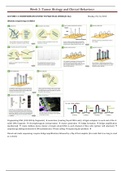College aantekeningen
Lecture Note - TBCB - week 2
Lectures included: bioinformatics, genomic data analysis (class discovery), tumor metabolism, tumor-stroma interaction, tumor angiogenesis & hypoxia, glioma & angiogenesis, CT colonography, cancer dissemination, circulating tumor cells, MRD detection (hematological malignancy), liquid biopsy,
[Meer zien]




